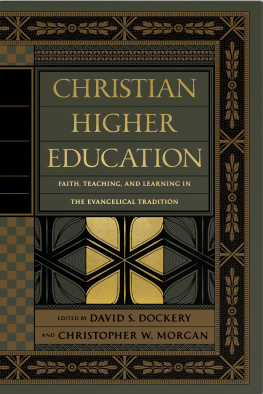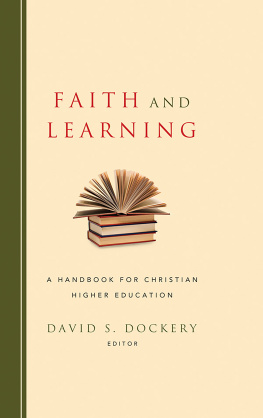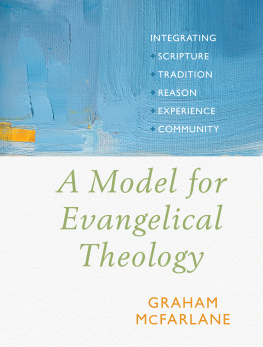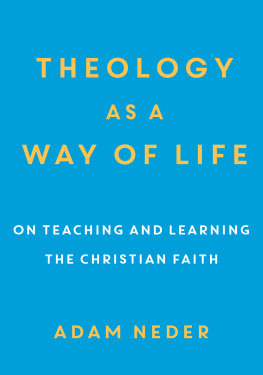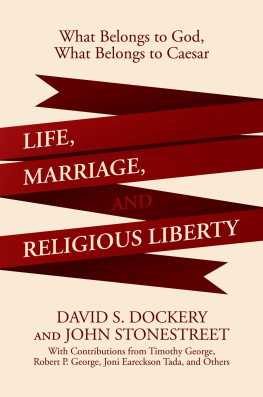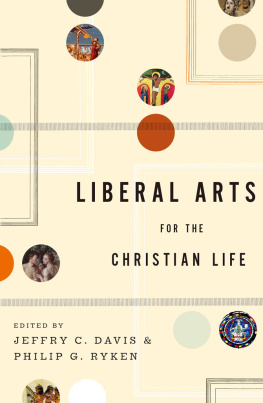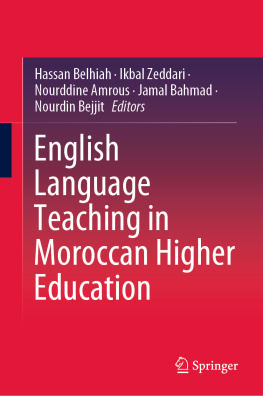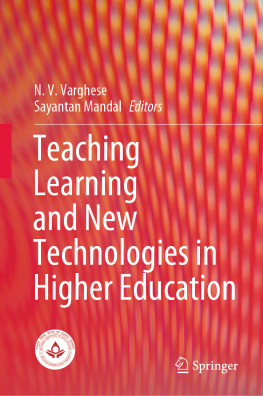David S. Dockery (editor) - Christian Higher Education: Faith, Teaching, and Learning in the Evangelical Tradition
Here you can read online David S. Dockery (editor) - Christian Higher Education: Faith, Teaching, and Learning in the Evangelical Tradition full text of the book (entire story) in english for free. Download pdf and epub, get meaning, cover and reviews about this ebook. year: 2018, publisher: Crossway, genre: Religion. Description of the work, (preface) as well as reviews are available. Best literature library LitArk.com created for fans of good reading and offers a wide selection of genres:
Romance novel
Science fiction
Adventure
Detective
Science
History
Home and family
Prose
Art
Politics
Computer
Non-fiction
Religion
Business
Children
Humor
Choose a favorite category and find really read worthwhile books. Enjoy immersion in the world of imagination, feel the emotions of the characters or learn something new for yourself, make an fascinating discovery.
- Book:Christian Higher Education: Faith, Teaching, and Learning in the Evangelical Tradition
- Author:
- Publisher:Crossway
- Genre:
- Year:2018
- Rating:3 / 5
- Favourites:Add to favourites
- Your mark:
- 60
- 1
- 2
- 3
- 4
- 5
Christian Higher Education: Faith, Teaching, and Learning in the Evangelical Tradition: summary, description and annotation
We offer to read an annotation, description, summary or preface (depends on what the author of the book "Christian Higher Education: Faith, Teaching, and Learning in the Evangelical Tradition" wrote himself). If you haven't found the necessary information about the book — write in the comments, we will try to find it.
Christian Higher Education: Faith, Teaching, and Learning in the Evangelical Tradition — read online for free the complete book (whole text) full work
Below is the text of the book, divided by pages. System saving the place of the last page read, allows you to conveniently read the book "Christian Higher Education: Faith, Teaching, and Learning in the Evangelical Tradition" online for free, without having to search again every time where you left off. Put a bookmark, and you can go to the page where you finished reading at any time.
Font size:
Interval:
Bookmark:
Thank you for downloading this Crossway book.
Sign-up for the Crossway Newsletter for updates on special offers, new resources, and exciting global ministry initiatives:
Crossway Newsletter
Or, if you prefer, we would love to connect with you online:
|
|
|
|
Implications for Teaching and Learning
John F. Kilner
All people are significant because they are in the
Oppressive misuse of the image of God concept has been possible because of a common misconception that being in Gods image is about how people are (actually) like God and unlike animals. This view understands being in Gods image in terms of attributes that people have now, most commonly peoples ability to reason, rule over (manage) creation, be righteous, or be in relationship. In this view, sin can damage such attributes and thus damage Gods image. Accordingly, people vary in the extent to which they have these attributesand are in Gods image.
This view has two primary implications. For many, it means that how much people warrant respect and protection as those in Gods image varies from person to person. The door to
The other implication of this view is that being in Gods image means people currently reflect some of Gods attributes. This way of defining the concept is more common among Christians who might logically be inclined by this view to respect some people over others but who are constrained by additional biblical teachings not to do so. In their case, a misunderstanding of Gods image leads not to oppression but to neutralizationneutralization of the liberating force that the image of God concept ought to unleash. Being in the image of God becomes a statement exclusively about who people are today, with their many unimpressive features, rather than about who they can be and ought to become.
Education (in both its teaching and its learning aspects) is animated by the opportunity for people to become more than they are at present. It requires understanding who people (teachers and students alike) are in order to facilitate meaningful growth. This requires identifiable standards. Since humanitys creation in the image of God concerns what people can become, based on who they are now, its no wonder that some have recognized that the exhilarating truth of imago Dei is central to what Christian education is all about.work needs to be done in the Christian educational community to clarify the meaning of this idea before applying it.
Remember, the problem here is not that a biblical idea has proved to be destructive or ineffective but that an unbiblical idea masquerading as a biblical idea has proved to be both. This idea is at odds with what the Bibles authors mean in describing humans as being created in Gods image and how they employ this concept in life situations. Accordingly, this chapter first develops a biblically sound understanding of what it means to be in Gods image. Then it introduces a number of important implications of this understanding for teaching and learning, in a way that opens the door to more detailed discussions of these implications in later chapters.
What It Means to Be in Gods Image
When the Bible talks about something as an image, it means that it has a connection with something else in a way that may also involve a reflection of it. Being the image of God in particular focuses this general idea somewhat. It involves having a special connection with God as well as being a substantial reflection of God. Having a special connection is significant because to mistreat the image means one is to mistreat the original as well. Being a substantial reflection is significant because that means the image displays attributes (capacities, traits, abilities, etc.) of the original to the extent that it is able.
The idea that being an image signifies having a special connection is evident, for example, in Daniel
4:4 similarly communicates that Christs image -o f -G od status involves connection with and reflection of God.
Being vs. Being in Gods Image
Whereas Christ is Gods image, the Bible states that people are in or according to Gods image. The insertion of a preposition indicates that people stand in some relationship with Gods image. The image -r elated passages in Genesis (1:26, 27; 5:1; 9:6) consistently feature a prepositionand not always the same onebetween people and the image. A preposition also appears in image -r elated passages in the New Testament that directly or indirectly refer to Genesis (e.g., Col. 3:10; James 3:9).
Its implausible that in each of these passages the author is simply saying that people are Gods image, as if there were no prepositions and no need to add them. In fact, prepositions such as in or according to make quite a difference. Saying that someone is in the water is quite different from saying that someone is the water. Saying that a violin is according to a paper blueprint is quite different from saying that the violin is a paper blueprint.
The Bibles authors use prepositions to distinguish the rest of humanity from Christ. With Christ not overtly in view as a reference point in the Old Testament, the recognition there would simply have been that people are not yet fully Gods image but are created according to
The Impact of Sin
Failing to take seriously the distinction between Christ being Gods image and humanity being in Gods image has contributed to overlooking a second important distinctionthat sin has damaged people, not damaged Gods image. If people were Gods image, then by damaging people, sin would plausibly damage Gods image. However, if people are created in (i.e., according to the standard of) Gods image, no damage is done to the standard just because people are later damaged.
There is ample discussion and documentation in the Bible regarding the destructive impact of sin on people. Yet at the same time, there is every indication that people remain in Gods imagethat no harm has been done to this status or to the image on which it is based (see Gen. 5:1; 9:6). People retain a special connection with God (though their relationship with God is badly damaged), and God still intends for people to reflect likenesses to God (though in actuality they largely fail to do so). The image of God is the standard of who people are created to be embodied in the person of Christand that standard is not diminished in any way because of sin. Similarly, in sanctification it is people who are being renewed. Gods unchanging image is the standard for that renewal (see Rom. 8:29; 2 Cor. 3:18; Col. 3:10).
What Exactly Is in Gods Image?
People, then, are created in (according to) Gods image, in a way unaffected by their fallenness. People (the adam [Heb.] of Gen. 1:27) refers not only to a single man named Adam but also to humanity as a whole. Contemporary readers can easily miss this point if they are located in societies like the United States that emphasize individuals, personal freedom, and autonomy. Connecting Gods image both to humankind as a whole and to each of the humans who constitute that kind of creation guards against a destructive overemphasis on individuals or collectives.
Equally important, being in Gods image has to do with people as entire beings (whether humanity as a whole or its component members are in view). There is no suggestion in the Bible that being in Gods image is constituted by particular attributes people have or once had (i.e., abilities, traits, capacities, or other things that people are, do, think, etc.). Select attributes (even if godlike) are not what are in Gods image; persons as a whole are. Accordingly, people with the best or most -d eveloped attributes are not more in Gods image than others are.
Next pageFont size:
Interval:
Bookmark:
Similar books «Christian Higher Education: Faith, Teaching, and Learning in the Evangelical Tradition»
Look at similar books to Christian Higher Education: Faith, Teaching, and Learning in the Evangelical Tradition. We have selected literature similar in name and meaning in the hope of providing readers with more options to find new, interesting, not yet read works.
Discussion, reviews of the book Christian Higher Education: Faith, Teaching, and Learning in the Evangelical Tradition and just readers' own opinions. Leave your comments, write what you think about the work, its meaning or the main characters. Specify what exactly you liked and what you didn't like, and why you think so.

